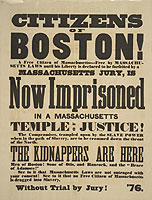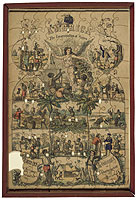![]()
Protest on Behalf of a Fugitive Slave
Citizens of Boston! A Free Citizen of Massachusetts—Free by Massachusetts
Laws until His Liberty is Declared to be Forfeited by a Massachusetts
Jury, is Now Imprisoned . . . Boston: s.n., ca. 1855.
Samuel J. May Anti-Slavery Collection
![]()
![]()
Jigsaw Puzzle
America, or, The Emancipation of Slaves. Jigsaw Puzzle (ca. 1860s).
Gift of Rita Guerlac
Spreading the Word
![]()
Fierce words and vivid images were among the tools that radical “immediatist”
abolitionists used to further their cause. Instead of gently pleading
their case, they employed sensational language to shock people into action
against slavery. On posters for abolitionist rallies and meetings, the
fervor of the language is matched only by its physical, typographical
boldness and size. This poster's appeal to the “Citizens of Boston”
and “Sons of Otis, and Hancock” to “see that Massachusetts
Laws are not outraged with your consent,” conjures up the signers
and the principles of the Declaration of Independence to stir the reader
to act in favor of the cause.
Realizing that sometimes words were inadequate, abolitionists also spoke through pictures. Images used to further anti-slavery agendas idealized and mythologized slaves, thus elevating the abolitionist cause. The jigsaw puzzle “America” offers a mythologized version of liberation by representing American emancipation as a white female, reminiscent of Nike, goddess of victory. Crowned by a halo of stars, carrying broken shackles in her right hand and ivy in her left, the woman stands above slaves, kneeling, praying, and praising her. The responsibility of salvation, the image implies, rests in white Americans’ hands.
| |
| |
| |
| |
| |
| |
| |
| |
| |
| |
| |
| |

Copyright © 2002 Division
of Rare & Manuscript Collections
2B Carl A. Kroch Library, Cornell University, Ithaca, NY, 14853
Phone Number: (607) 255-3530. Fax Number: (607) 255-9524
For reference questions, send mail to:
rareref@cornell.edu
For questions or comments about the site, send mail to: webmaster.

